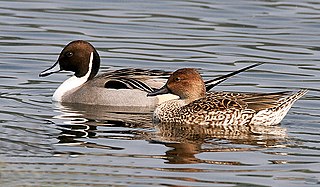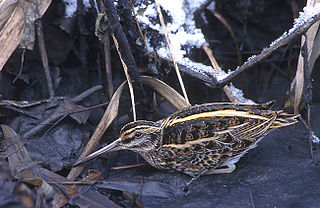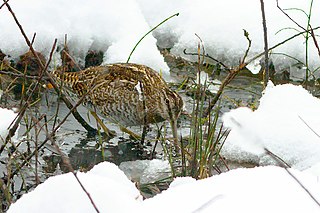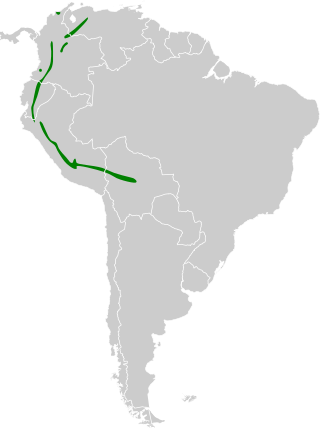
The pintail or northern pintail is a duck species with wide geographic distribution that breeds in the northern areas of Europe and across the Palearctic and North America. It is migratory and winters south of its breeding range to the equator. Unusually for a bird with such a large range, it has no geographical subspecies if the possibly conspecific duck Eaton's pintail is considered to be a separate species.

The common snipe is a small, stocky wader native to the Old World.

Wilson's snipe is a small, stocky shorebird. The generic name Gallinago is Neo-Latin for a woodcock or snipe from Latin gallina, "hen" and the suffix -ago, "resembling". The specific name delicata is Latin for "dainty".

The black-tailed godwit is a large, long-legged, long-billed shorebird first described by Carl Linnaeus in 1758. It is a member of the godwit genus, Limosa. There are four subspecies, all with orange head, neck and chest in breeding plumage and dull grey-brown winter coloration, and distinctive black and white wingbar at all times.

The jack snipe or jacksnipe is a small stocky wader. It is the smallest snipe, and the only member of the genus Lymnocryptes. Features such as its sternum make it quite distinct from other snipes or woodcocks.

The great snipe is a small stocky wader in the genus Gallinago. This bird's breeding habitat is marshes and wet meadows with short vegetation in north-eastern Europe, including north-western Russia. Great snipes are migratory, wintering in Africa. The European breeding population is in steep decline.

The pin-tailed sandgrouse is a medium large bird in the sandgrouse family. It has a small, pigeon like head and neck and a sturdy, compact body. It has long pointed wings, which are white underneath, a long tail and a fast direct flight. Flocks fly to watering holes at dawn. The call is a loud kattar-kattar. This gregarious species breeds on dry open treeless plains and similar habitats. Its nest is a ground scrape into which two or three cream-coloured eggs with cryptic markings are laid. Both sexes incubate the eggs.

The puna snipe is a bird in tribe Scolopancinai and subfamily Scolopacinae of family Scolopacidae, the sandpipers and relatives. It is found in Argentina, Bolivia, Chile, and Peru.

The wood snipe is a species of snipe which breeds in the Himalayas of northern India, Nepal, Bhutan and southern China. In winter, it occurs at lower altitudes in the Himalayas, as a regular visitor in small numbers to north Vietnam. it also occurs as a vagrant in central and southern India, Sri Lanka, Bangladesh, Myanmar, north Thailand and Laos. It is reportedly very well-known to Chauri herders in the Himalayas.

Latham's snipe, also known as the Japanese snipe, is a medium-sized, long-billed, migratory snipe of the East Asian–Australasian Flyway.

Swinhoe's snipe,, also known as forest snipe or Chinese snipe, is a medium-sized, long-billed, migratory wader.

The African snipe also known as the Ethiopian snipe, is a small stocky wader. It breeds in eastern and southern Africa in wet mountain moorland and swamps at altitudes of 1,700–4,000 m (5,600–13,100 ft). When not breeding it disperses widely, including into coastal lowlands.

The Madagascar snipe is a small stocky wader. It breeds only in the humid eastern half of Madagascar, from sea-level up to 2,700 m, being more common above 700 m. It is non-migratory.

The solitary snipe is a small stocky wader. It is found in the Palearctic from northeast Iran to Japan and Korea.

The Fuegian snipe also known as the cordilleran snipe, is a small stocky wader. It breeds in south-central Chile and Argentina south to Tierra del Fuego. It is mainly sedentary, but the Tierra del Fuego population winters in mainland Chile.

The Jameson's snipe or Andean snipe is a small, stocky wader. It breeds in the Andes in Bolivia, Colombia, Ecuador, Peru and Venezuela. It appears to be entirely sedentary, with no evidence of migration.

The imperial snipe is a small stocky wader which breeds in the Andes. For a century it was known only from two specimens collected near Bogotá, Colombia, and was presumed extinct, but it was rediscovered in Peru in 1967 and Ecuador in 1988. It is not known if it is migratory.

The Magellanic snipe is a bird in tribe Scolopancinai and subfamily Scolopacinae of family Scolopacidae, the sandpipers and relatives. It is found in Argentina, Chile, Uruguay, and the Falkland Islands.




















